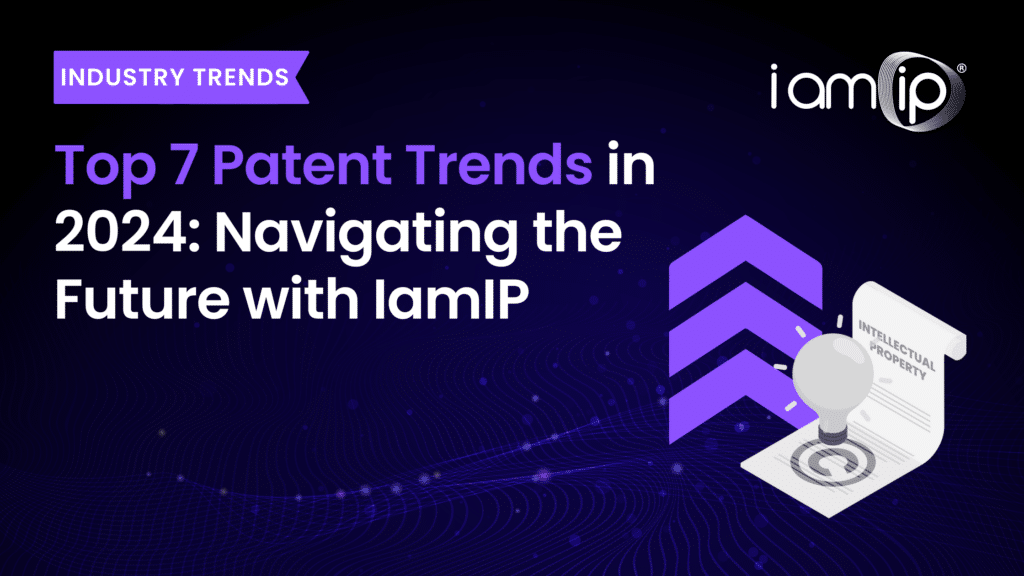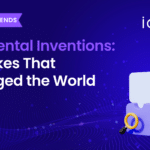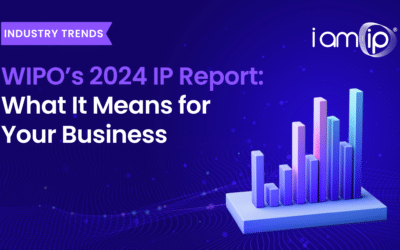
2024 is the year of exploration across all industries. With numerous products, services, and innovations brimming the market today from corporations and individuals alike, it has become imperative for everyone to be constantly in tune with the trends of Intellectual Property (IP) registration.
In this blog, we’ll go through the top 7 patent trends in 2024, and how you can navigate the future with IamIP to ensure you can make the most out of your creations.
Trend #1: AI-Driven Expansion
The Intellectual Property Services Market is poised to witness significant growth, with a projected annual rise of a magnificent CAGR from 2024 to 2031. The market, valued at USD 2594.78 million in 2021, is expected to expand at a CAGR of 12.31%, reaching USD 5207.62 million by 2027.
Unfortunately, such immense growth is still not enough to cope with the ever-evolving creation process. In fact, the World Intellectual Property Organization received nearly 3.5 million patent applications last year – a record high.
Quantity isn’t the only thing to consider. Business experts suggest that 2024 will be the year of the AI thud, in which businesses, corporations, and SMEs alike, would likely integrate Generative AI and Machine Learning solutions into their operations. Consequently, the rise of generative AI introduces complexities in the intellectual property market as it challenges traditional notions of authorship and ownership, leading to debates around the legal status of AI-generated content.
This shift necessitates a reevaluation of existing IP frameworks to address novel questions surrounding the rights and responsibilities associated with AI-generated creations.
Trend #2: Blurring Virtual and Real Worlds
In 2024, the patent landscape for Virtual Realities (VR) is poised for significant development. The success of Sony in patenting their groundbreaking VR Metaverse headset in 2023 signifies the beginning of the patent trend for VRs, especially within the realm of Metaverse.
The patent applications related to VRs are most focused on the legality of detecting and replicating real-world objects in the digital realm, thereby elevating immersion and realism. IP applications are expected to extend across diverse industries, ranging from product development and skills training to retail shopping and telemedicine. While the market is still relatively flimsy, the short-term outlook foresees a surge in AR/VR-related patents and trademarks, reflecting the growing market value of AR/VR/MR from $30.7 billion to an estimated $300 billion by 2024.
Trend #3: Data Analytics in IP Management
Data management will be the heart of almost all industries this coming 2024. According to Forbes, the world produces 2.5 quintillion bytes of data every day all of which could guide innovators and creators on their invention. Because of this, it has become imperative for businesses to integrate AI in IP management to efficiently go through their data. Here are key processes anticipated in upcoming IP management technologies:
- Modernizing Data Integration: AI-infused automation will be a focal point, expecting a surge in unified data platforms and data virtualization.
- Integrated Access to Historical and Real-time Data: A heightened emphasis on providing users with more integrated access to historical and real-time data, redefining approaches to transactional Business Intelligence (BI) reporting and analytics.
- Technology-Driven Data Governance: Technology plays a crucial role in automating and enhancing the agility of data governance, with AI-driven automation being instrumental in modernizing data governance practices.
This integration of data management trends is set to shape a future where data becomes a dynamic force, propelling strategic decision-making, fostering innovation, and contributing to overall business success.
Trend #4: Sustainability and IP
Patent trends underscore a growing focus on eco-sustainability, particularly in retail, industrial, and automotive industries. While most businesses have shrugged off the market demand for eco-consciousness for quite some time now, their respective consumers have been pulling strings pressuring brands to embrace more sustainable operations. In fact, organizations call for accelerated fashion sustainability by 2024 since only 420 patents related to the environment were published, 206 filed, and 207 granted from the fashion industry since 2022.
The urgency to address environmental challenges and the increasing market demand for eco-friendly solutions are driving innovation in sustainable technologies. This shift is evident in the growing commitment of businesses to combat climate change, as green patent applications are expected to surge by over 60% by 2025.
Trend #5: Legal Department Digitalization and Automation
The digitalization and automation of legal departments are expected to have profound effects on the intellectual property (IP) industry by 2024. These advancements are likely to enhance efficiency and reduce costs within legal processes, particularly in tasks such as document review, trademark searches, and patent filings.
The implementation of automation tools within industries can streamline routine operations, allowing legal professionals in the IP sector to focus on strategic decision-making and more complex aspects of their work. Additionally, digital platforms and collaboration tools facilitate improved communication and coordination within legal teams, clients, and external stakeholders.
Trend #6: Impact of Legislative Changes
As technology empowers individuals and businesses to introduce a myriad of innovations to their markets, governments are increasingly stringent in monitoring and implementing intellectual property (IP) laws. Here are some of the legislative changes which are expected to change the IP industry in 2024:
1. PREVAIL Act
The PREVAIL Act is poised to impact Patent Trial and Appeal Board (PTAB) procedures, intending to raise the standard for proving patent invalidity. Notably, challengers are now required to be sued before filing, introducing a procedural shift in IP litigation.
2. Patent Eligibility Restoration Act (PERA) of 2023
The Patent Eligibility Restoration Act (PERA) of 2023 addresses concerns surrounding patent eligibility under Section 101. Its objectives include eliminating judicially created exceptions and offering guidance on computer-related inventions, aiming to bring clarity to this critical aspect of IP law.
3. Protecting American Intellectual Property Act of 2022 (PAIPA)
The Protecting American Intellectual Property Act of 2022 (PAIPA) focuses on strengthening the U.S. enforcement of IP rights against foreign actors. This act imposes sanctions on entities engaged in trade secret theft and extends the statute of limitations for criminal trade secret theft, reinforcing measures against intellectual property infringement.
4. National AI Initiative Act of 2023
The National AI Initiative Act of 2023 introduces a comprehensive national strategy for artificial intelligence (AI) development. Emphasizing research and development (R&D), workforce training, and international collaboration, it establishes the National AI Advisory Committee to guide the country’s AI efforts.
5. NO FAKES Act
The NO FAKES Act aims to enhance accountability in the e-commerce sector by holding platforms responsible for counterfeit goods. This legislation grants enforcement authority to the Department of Homeland Security (DHS) and Customs and Border Protection (CBP) and empowers rights holders to initiate civil actions against infringement.
6. Digital Asset Legislation
In the realm of digital assets, new legislation focuses on consumer protection and market integrity. These measures, including anti-manipulation safeguards, seek to provide regulatory clarity, fostering innovation in the dynamic digital asset space.
These legislative changes reflect a dynamic legal landscape, requiring businesses to adapt and align their IP strategies accordingly.
Trend #7: Automation of Patent Management
In 2024, automation is poised to revolutionize the landscape of intellectual property (IP) management by streamlining processes, enhancing efficiency, and reducing the risk of errors. Advanced AI algorithms and machine learning systems can analyze vast amounts of data, accelerating the patent search and filing process.
Automation tools can also aid in monitoring and enforcing IP rights, detecting potential infringements more swiftly than traditional methods. Additionally, smart contract technology powered by blockchain can automate licensing agreements, ensuring transparent and secure transactions. As a result, businesses can expect reduced administrative burdens, faster decision-making, and improved overall management of their intellectual property portfolios.
Furthermore, this shift brought by automation prompts a strategic reassessment within law firms and IP businesses alike. Ian Schick’s examination of the future of patent practices highlights the impact of AI on the traditional triad of Counseling, Production, and Services layers. With automation taking over routine tasks in the Production Layer, law firms and IP businesses are presented with opportunities to redefine their roles. This includes offering specialized services, acting as AI brokers, and exploring domains such as patent valuation and monetization.
Making Your IP Management Process 2024-Ready with IamIP
IamIP emerges as a pivotal asset for businesses preparing for the 2024 landscape by offering a Smart Patent Search & Monitoring Platform that leverages automation and collaboration. Their use of Artificial Intelligence, notably the AI Categorizer, enables automatic identification of pertinent documents in competitor tracking and specific technology domains. The platform’s features encompass actionable alerts, robust global patent database search capabilities, and dynamic collaboration tools, enhancing team efficiency.
Moreover, IamIP prioritizes accessibility through a user-friendly interface, tailored for time-constrained individuals, and ensures data security. Beyond user-friendliness, the platform automates crucial processes, such as delivering alerts, competitor monitoring, and tracking legal changes in patent documents, saving time and fostering streamlined communication.
IamIP’s comprehensive approach facilitates the rapid acquisition of competitive knowledge, enabling businesses to effortlessly capture market insights and collaborate seamlessly in crafting technical solutions for the dynamic landscape of 2024.
Final Thought
These 2024 IP trends reflect a dynamic environment where businesses must adapt to emerging technologies, regulatory shifts, and environmental considerations. Successful navigation of this landscape requires strategic foresight, innovative approaches, and a proactive stance toward evolving patent and intellectual property dynamics.
Search
Categories
- Announcement 6
- Case Study 1
- Expert Insights 7
- IamIP News 4
- Industry Trends 27
- Innovation Index 4
- New Release 9
- Platform News 2
- Press Release 1
- Webinar 13









